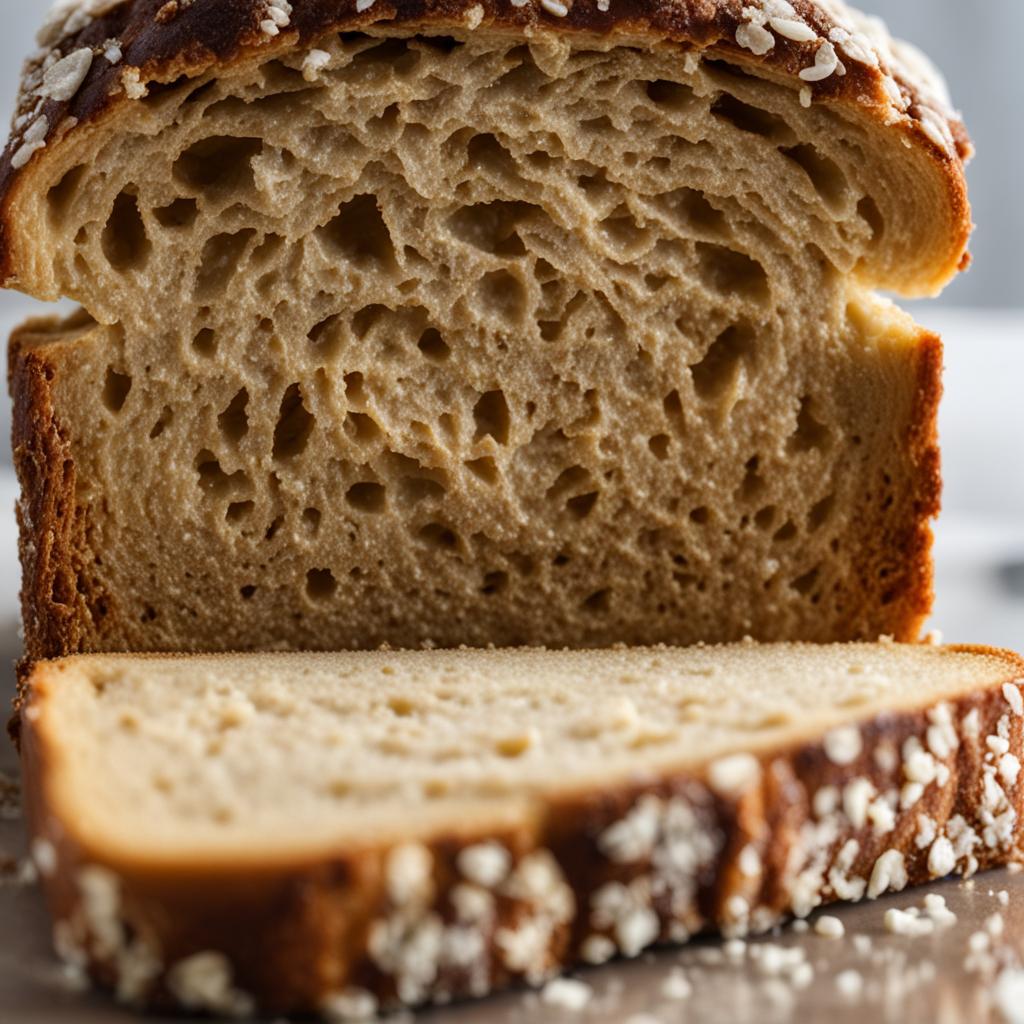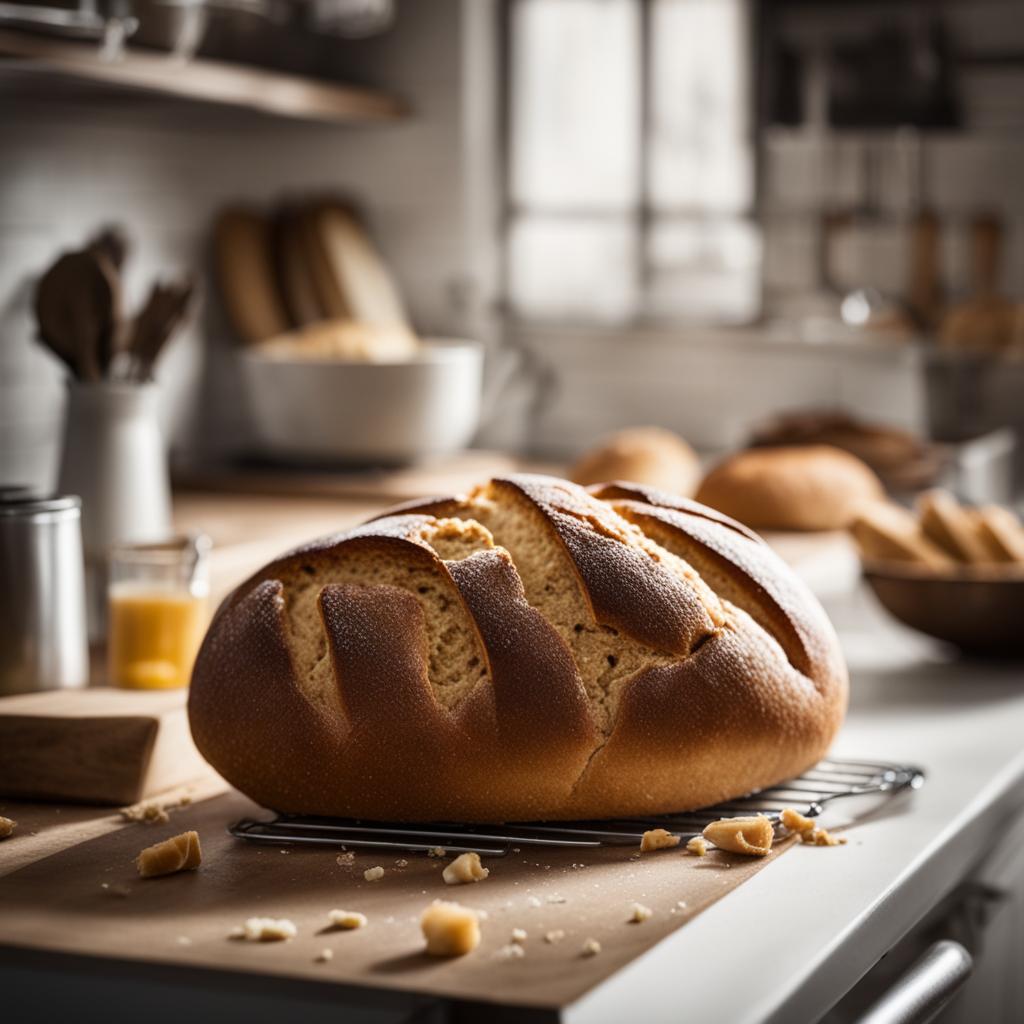Greetings! Today, I want to share some insights on how to tell if bread is bad and recognize signs of staleness. We all love the smell and taste of fresh bread, but it’s important to know when it’s time to bid farewell to that loaf from the bakery. Let’s dive in and explore the key indicators of bread freshness and spoilage.
Key Takeaways:
- Recognizing stale bread is crucial for maintaining food safety and freshness.
- Factors like ingredients, type of bread, and storage method affect the shelf life of bread.
- Stale bread may exhibit signs such as hardness, dryness, changes in color, and less fluffy texture.
- Mold on bread should be avoided, as it can produce harmful mycotoxins.
- Expired bread, especially if it contains mold, can pose health risks such as digestive problems and weakened immune system.
Factors Affecting Bread’s Shelf Life
When it comes to the shelf life of bread, several factors come into play, including the type of bread, ingredients used, and storage method. Understanding these factors can help you make informed decisions about your bread consumption and storage practices.
Type of Bread: Different types of bread have different shelf lives. For example, sandwich bread, loaf bread, or bakery bread often contain preservatives to prevent mold and increase longevity. On the other hand, gluten-free bread, due to its higher moisture content, is more prone to mold and has a shorter shelf life.
Ingredients: The ingredients used in bread can also affect its shelf life. Homemade bread and some bakeries avoid preservatives, relying on perishable ingredients. This can make the bread more susceptible to spoilage and reduce its shelf life compared to commercially produced bread.
Storage Method: How you store your bread plays a crucial role in its freshness and shelf life. Bread that is stored in warm and moist environments is more likely to spoil quickly. Proper storage, such as sealing the bread in an airtight bag and refrigeration, can help extend its shelf life. Freezing bread is also an effective method, with frozen bread lasting up to 6 months.
| Type of Bread | Preservatives | Shelf Life |
|---|---|---|
| Sandwich Bread | Yes | Longer shelf life |
| Loaf Bread | Yes | Longer shelf life |
| Bakery Bread | Yes | Longer shelf life |
| Gluten-Free Bread | No/Limited | Shorter shelf life |
| Homemade Bread | No/Limited | Shorter shelf life |
Signs of Stale Bread
To determine if bread has gone stale, there are several signs to look out for. These indicators include hardness, dryness, and changes in color.
Stale bread often becomes harder and less soft and fluffy compared to fresh bread. You may notice that it requires more effort to slice or chew. Additionally, stale bread can become dry, resulting in a less enjoyable texture.
Another visual clue of stale bread is a change in color. The crust may darken, and the interior of the bread may lose its vibrant appearance.
While stale bread may still be safe to consume if there is no mold present, it may not taste as good as fresh bread. It is always best to use your judgment and consider these signs before deciding whether to enjoy the bread or discard it.
Recognizing Mold on Bread
When it comes to bread, one of the most common signs of spoilage is the presence of mold. Mold on bread can be easily recognized by its appearance and should not be ignored. The United States Department of Agriculture (USDA) advises discarding the whole loaf if mold is present, as it can produce harmful mycotoxins.
The color and texture of the mold can vary, ranging from green and black to white or even pink. These fuzzy spots are a clear indication that the bread has spoiled and should not be consumed. Mold growth on bread can pose health risks, so it’s essential to prioritize safety when it comes to food consumption.
“Mold on bread can produce harmful mycotoxins, so it’s best to avoid consuming moldy bread.”
Remember to carefully inspect your bread before consuming it. If you notice any mold, it’s safest to throw it away. Moldy bread can cause allergic reactions, respiratory distress, and even food poisoning. To ensure your well-being, always prioritize fresh and mold-free bread.
| Type of Mold | Color | Texture | Safety |
|---|---|---|---|
| Aspergillus | Green or black | Fuzzy | Potentially harmful |
| Penicillium | Blue or green | Fuzzy | Potentially harmful |
| Rhizopus | White or gray | Fuzzy | Potentially harmful |
| Cladosporium | Black or green | Fuzzy or powdery | Potentially harmful |
Table: Common Types of Mold on Bread
Evaluating Bread’s Odor and Taste
When it comes to determining the freshness of bread, evaluating its odor and taste can be key indicators. An unpleasant odor can be a clear sign that the bread has gone bad. If you detect a strange smell, it’s best to trust your instincts and discard the loaf. Moldy bread can release spores that may be harmful to inhale, so it’s important to prioritize your health and safety.
Similarly, if the bread doesn’t taste right, it’s safest to avoid consuming it. Even if there is no visible mold, a strange taste can be a strong indication that the bread has passed its prime. Trust your taste buds and consider the overall quality of the bread when making the decision to consume or discard.
Remember, your senses are powerful tools when it comes to assessing the freshness of bread. If the odor is off-putting or the taste is not up to par, it’s best to err on the side of caution and choose a fresh loaf instead.
Table: Signs of Stale Bread
| Signs of Stale Bread | Description |
|---|---|
| Hardness | Bread that has become stale may feel harder and less soft and fluffy compared to fresh bread. |
| Dryness | Improperly stored bread can become dry and lose its moisture, indicating staleness. |
| Color Change | The crust of stale bread can become darker, and the interior may lose its vibrant color. |
Risks of Eating Expired Bread
Consuming expired bread, especially if it has mold, can be risky for your health. Some molds produce mycotoxins, which are poisons that can be dangerous if consumed. Mycotoxins can cause digestive problems, disrupt gut bacteria, weaken the immune system, and potentially increase the risk of certain cancers. It’s crucial to throw away the whole loaf if mold is present.
When bread reaches its expiration date, it’s important to pay attention to any signs of mold growth. Mold on bread can release harmful mycotoxins that pose health risks when ingested. These toxins can have various negative effects on the body, including gastrointestinal issues such as nausea, vomiting, and diarrhea. In severe cases, mycotoxins can even lead to organ damage.
Expired bread can also harbor other types of bacteria and fungi that may cause food poisoning or allergic reactions. The presence of these microorganisms can lead to symptoms like stomach cramps, fever, muscle aches, and rashes. It’s essential to prioritize food safety and take precautions when it comes to consuming expired bread.
Table: Health Risks Associated with Eating Expired Bread
| Health Risks | Symptoms |
|---|---|
| Mycotoxin ingestion | Digestive problems, disrupted gut bacteria, weakened immune system, increased risk of certain cancers |
| Food poisoning | Stomach cramps, nausea, vomiting, diarrhea |
| Allergic reactions | Rashes, itching, sneezing, watery eyes |
It’s essential to prioritize your health and dispose of expired bread properly. Do not attempt to salvage moldy bread by cutting off the affected parts, as the mycotoxins may have already spread throughout the loaf. Play it safe and always opt for fresh bread to avoid any potential health risks.
Tips for Preventing Bread Waste
When it comes to bread, preventing waste is not only good for your budget but also for the environment. Here are some tips to help you make the most out of your bread and avoid unnecessary waste:
1. Repurpose Leftover Bread
Don’t throw away stale bread! Instead, get creative and find new uses for it. You can make homemade croutons by cutting the bread into small cubes, tossing them with olive oil and your favorite seasonings, and then baking them until crispy. Croutons are a delicious addition to salads and soups. Another option is to turn stale bread into breadcrumbs by simply processing it in a food processor or blender. Breadcrumbs can be used as a coating for chicken or fish, or to add texture to meatballs and casseroles.
2. Proper Storage
To keep your bread fresh for longer, it’s important to store it correctly. If you have extra bread that you won’t be using right away, consider freezing it. Wrap the bread tightly in aluminum foil or place it in a freezer-safe bag before placing it in the freezer. Frozen bread can last for up to 6 months. If freezing is not an option, store your bread in a cool and dry area, such as a bread box or a pantry. Make sure it is sealed in an airtight bag or container to prevent moisture and mold growth.
3. Plan Your Portions
If you often find yourself with leftover bread that ends up going to waste, it may be helpful to plan your portions more effectively. Consider buying smaller loaves or individual servings of bread that you know you will finish within a few days. This can help reduce the chances of bread going stale or moldy before you have had a chance to enjoy it.
By following these tips, you can prevent bread waste and make the most out of every loaf. Remember to get creative with repurposing stale bread and to store it properly to maintain its freshness for as long as possible.
Importance of Best-By Dates
In the world of bread, best-by dates play a significant role in indicating the recommended period for optimal freshness. While these dates can give us a general idea of how long the bread will stay fresh, it’s important to note that they do not guarantee safety. To determine the actual freshness and edibility of bread, it’s essential to visually inspect it for signs of spoilage. Mold, odor, taste, and texture are better indicators of whether the bread has gone bad.
When it comes to assessing the freshness of bread, our senses are key. Take a close look at the bread and check for any visible mold. This can appear as fuzzy spots in various colors such as green, black, white, or even pink. If mold is present, it’s best to discard the entire loaf to avoid any potential health risks. Mold can produce harmful mycotoxins, which can be dangerous if consumed.
Aside from mold, pay attention to the bread’s odor and taste. If the bread gives off an unpleasant smell or has an off-putting taste, it’s a clear sign that it has gone bad. Even if there is no visible mold, it’s safest to trust your senses and dispose of the loaf. It’s always better to be cautious when it comes to food safety.

Remember, the best-by date is a guideline, but it’s not the sole determining factor in the freshness of bread. By utilizing your senses and understanding the signs of spoilage, you can ensure that you are consuming bread that is safe to eat.
Food Safety Concerns with Moldy Bread
When it comes to consuming moldy bread, there are several food safety concerns that we should be aware of. Mold can pose various risks to our health, including allergic reactions, respiratory distress, and even food poisoning. Some individuals may experience allergic reactions to mold, resulting in symptoms such as sneezing, watery eyes, itching, and skin irritations. Those with asthma may be particularly susceptible to respiratory distress, which can manifest as wheezing, coughing, shortness of breath, and chest tightness.
In addition to allergic reactions and respiratory distress, consuming moldy bread can also lead to food poisoning. Mold can produce mycotoxins, which are poisons that can be harmful if ingested. The symptoms of food poisoning include nausea, vomiting, abdominal cramping, diarrhea, fever, and dehydration. It’s important to note that these symptoms can vary in severity depending on the individual and the type of mold present on the bread.
If you experience any symptoms after consuming moldy bread, it’s crucial to seek medical attention. While some individuals may only experience mild discomfort, others may have more severe reactions. It’s always better to err on the side of caution and consult a healthcare professional if you have any concerns about your health after consuming moldy bread.
Risks of Consuming Moldy Bread:
- Allergic reactions (sneezing, watery eyes, itching, skin irritations)
- Respiratory distress (wheezing, coughing, shortness of breath, chest tightness)
- Food poisoning (nausea, vomiting, abdominal cramping, diarrhea, fever, dehydration)
Consumer Quote:
“I once unknowingly ate a sandwich made with moldy bread, and it resulted in a severe allergic reaction. I had no idea that mold could cause such a strong response in my body. Now I’m always careful to check my bread for any signs of mold before eating it.” – Sarah, New York
Helpful Tips to Extend Bread’s Lifespan
When it comes to preventing bread waste and maximizing its shelf life, there are a few helpful tips to keep in mind. While bread doesn’t have a fixed expiration date, it does have a best-by date that indicates optimal freshness. However, you can continue enjoying bread until it shows signs of mold, sourness, or staleness. Here are some strategies to help you extend the lifespan of your bread:
- Freezing: Freezing bread can help prolong its freshness. Before freezing, slice the bread and place it in airtight bags or containers. When you’re ready to enjoy the bread, simply toast or thaw it in a toaster or microwave.
- Storage: If freezing is not an option, store bread in a cool and dry area. It’s important to keep the bread sealed in an airtight bag or container to maintain freshness and prevent bacterial growth.
By following these tips, you can prevent bread waste and ensure that your bread stays fresh for as long as possible. Whether you enjoy your bread toasted, buttered, or plain, these storage methods will help you maintain its optimal quality.

Summary
To extend the lifespan of bread, consider freezing it or storing it in a cool, dry area in an airtight bag. Freezing bread can help prolong its freshness, while proper storage methods can prevent bacterial growth and maintain its quality. By following these tips, you can prevent bread waste and enjoy your bread for longer.
Safely Enjoying Bread: Tips for Food Safety and Snacking
When it comes to enjoying bread, food safety is of utmost importance. By following a few simple tips, you can ensure that your bread consumption is safe and worry-free. Whether you enjoy bread as a quick snack or a staple in your meals, here are some guidelines to keep in mind:
- Check for signs of spoilage: Before consuming bread, always check for signs of mold, strange odor, or changes in texture and color. Moldy bread should be discarded to avoid potential health risks.
- Store bread properly: To maintain freshness and prevent bacterial growth, store bread in a cool and dry area in an airtight bag. Alternatively, freezing bread can help extend its shelf life.
- Optimize bread’s lifespan: While bread doesn’t have a fixed expiration date, it’s best to consume it before it shows signs of mold, sourness, or staleness. Repurpose stale bread into delicious dishes like French toast or homemade croutons.
- Enjoy bread as a snack: Bread can be a versatile and satisfying snack option. Whether you prefer it toasted, buttered, or plain, you can confidently indulge in bread as long as it’s fresh and free from spoilage.
By following these simple tips, you can continue to enjoy bread safely and confidently. Make sure to prioritize food safety and be mindful of the signs of spoilage. With proper storage and knowledge about bread freshness, you can savor this versatile snack without any worries.
Remember, bread is not only a delicious choice, but also a convenient and budget-friendly option for college students. However, it’s crucial for students to be aware of the expiration date and signs of spoilage. Throw away any moldy bread to avoid potential health risks, and get creative with repurposing stale bread into tasty dishes. Proper storage in the freezer or a cool, dry area will help optimize the lifespan of your bread and reduce food waste.
So go ahead, enjoy that slice of bread with confidence and discover the many ways you can incorporate it into your meals and snacks. Bread is a timeless classic that can be enjoyed safely and deliciously when stored properly and consumed before signs of spoilage appear. Happy snacking!
Bread: A College Student’s Perspective
As a college student, bread has become a staple in my daily diet. Its versatility, affordability, and convenience make it the perfect option for quick and easy meals. However, it’s important to be mindful of the expiration date and signs of spoilage to ensure I’m consuming bread that is safe and fresh.
One of the first things I learned is to always check the expiration date before purchasing bread. It’s easy to get caught up in the hustle and bustle of college life and overlook this important detail. Consuming bread that has passed its expiration date can put my health at risk. Mold is a common issue with expired bread, and consuming moldy bread can lead to uncomfortable symptoms and even food poisoning.
To avoid any health risks, I make it a habit to thoroughly inspect my bread before consumption. I look for signs of mold, both on the surface and inside the packaging. If I spot any mold, no matter how small, I immediately discard the entire loaf. It’s better to be safe than sorry when it comes to my well-being.
Another challenge college students face is managing a tight food budget. Bread is an affordable option that provides nourishment and sustenance. By properly storing bread, I can help extend its shelf life and avoid unnecessary waste. I often freeze bread that I won’t consume within a few days. Freezing keeps the bread fresh and allows me to defrost and enjoy it at my convenience.
In addition to freezing, I store my bread in a cool and dry area, sealed in an airtight bag. This helps prevent mold growth and maintains the freshness of the bread. By following these simple storage tips, I can make the most out of my food budget and minimize food waste.
Conclusion
In conclusion, understanding bread freshness and practicing food safety is essential for enjoyable and safe consumption. By recognizing the signs of spoilage such as mold, unpleasant odor, strange taste, hardness, and changes in texture and color, you can quickly determine if your bread has gone bad.
To ensure the longest possible shelf life of your bread, it’s important to follow proper storage tips. Freezing bread can help maintain its freshness for an extended period, while storing it in a cool and dry area, sealed in an airtight bag, can prevent bacterial growth and mold formation. Remember, bread doesn’t have a fixed expiration date, so it’s best to use your senses and check for signs of spoilage before consuming.
By being mindful of these storage tips and understanding the indicators of bread spoilage, you can prevent unnecessary waste and enjoy bread safely. Discard any moldy bread, as consuming it can pose health risks due to the potential presence of harmful mycotoxins. If you experience any symptoms after consuming spoiled bread, seek medical attention to ensure your well-being.
Remember, bread is a versatile and delicious food that can be enjoyed for various meals and snacks. With proper storage and knowledge of food safety guidelines, you can confidently incorporate bread into your diet, knowing that you’re making informed choices and minimizing the risk of consuming spoiled bread.
FAQ
How can I recognize stale bread?
Stale bread can be recognized by its hardness, less soft and fluffy texture, and changes in color.
What factors affect the shelf life of bread?
The shelf life of bread is influenced by ingredients, type of bread, and storage method.
What are the signs of stale bread?
Stale bread can be identified by its hardness, dryness, and changes in color.
How can I recognize mold on bread?
Mold on bread appears as fuzzy spots that can be green, black, white, or pink in color.
How should I evaluate the odor and taste of bread?
If bread has an unpleasant odor or taste, it is best to discard it.
What are the risks of eating expired bread?
Consuming expired bread, especially if it has mold, can pose health risks due to potential mycotoxin production.
How can I prevent bread waste?
You can repurpose stale bread by making croutons, breadcrumbs, bread pudding, or French toast. Properly sealing and storing leftover bread in the freezer can also extend its shelf life.
What is the importance of best-by dates on bread?
Best-by dates indicate the recommended period for optimal freshness, but visual inspection is necessary to determine if the bread has gone bad.
What are the food safety concerns with moldy bread?
Moldy bread can cause allergic reactions, respiratory distress, and food poisoning.
What are some helpful tips to extend bread’s lifespan?
Freezing bread, proper storage in a cool and dry area, and using bread before its best-by date can help prolong its freshness.
How can I enjoy bread safely?
By following food safety guidelines and checking for signs of spoilage, you can safely enjoy bread as a snack or in meals.
What considerations should college students have regarding bread?
College students should be aware of the bread’s expiration date and signs of spoilage to avoid potential health risks and prevent food waste.
Source Links
- https://spoonuniversity.com/lifestyle/bread-has-gone-bad-or-if-i-can-still-eat-it-how-do-i-know-if-my
- https://www.thedailymeal.com/1164324/ditch-your-bread-expiration-date-how-to-know-if-your-loaf-has-actually-gone-bad/
- https://www.healthline.com/nutrition/how-long-does-bread-last
Related Recipes:
 How Long Can Yogurt Sit Out? Guidelines and Safety
How Long Can Yogurt Sit Out? Guidelines and Safety
 Can You Eat Expired Butter? What You Need to Know
Can You Eat Expired Butter? What You Need to Know
 Spotting Spoiled Blue Cheese: How to Tell If Blue Cheese is Bad
Spotting Spoiled Blue Cheese: How to Tell If Blue Cheese is Bad
 Does Almond Milk Go Bad? How to Tell and Storage Tips.
Does Almond Milk Go Bad? How to Tell and Storage Tips.
 How to Store Bread to Preserve Its Freshness
How to Store Bread to Preserve Its Freshness
 Does Peanut Butter Go Bad? Shelf Life and Storage Tips
Does Peanut Butter Go Bad? Shelf Life and Storage Tips
 Pineapple Storage: Tips for Longevity
Pineapple Storage: Tips for Longevity
 Beef Stew Shelf Life: How Long Does It Last in the Fridge?
Beef Stew Shelf Life: How Long Does It Last in the Fridge?








